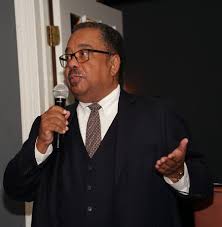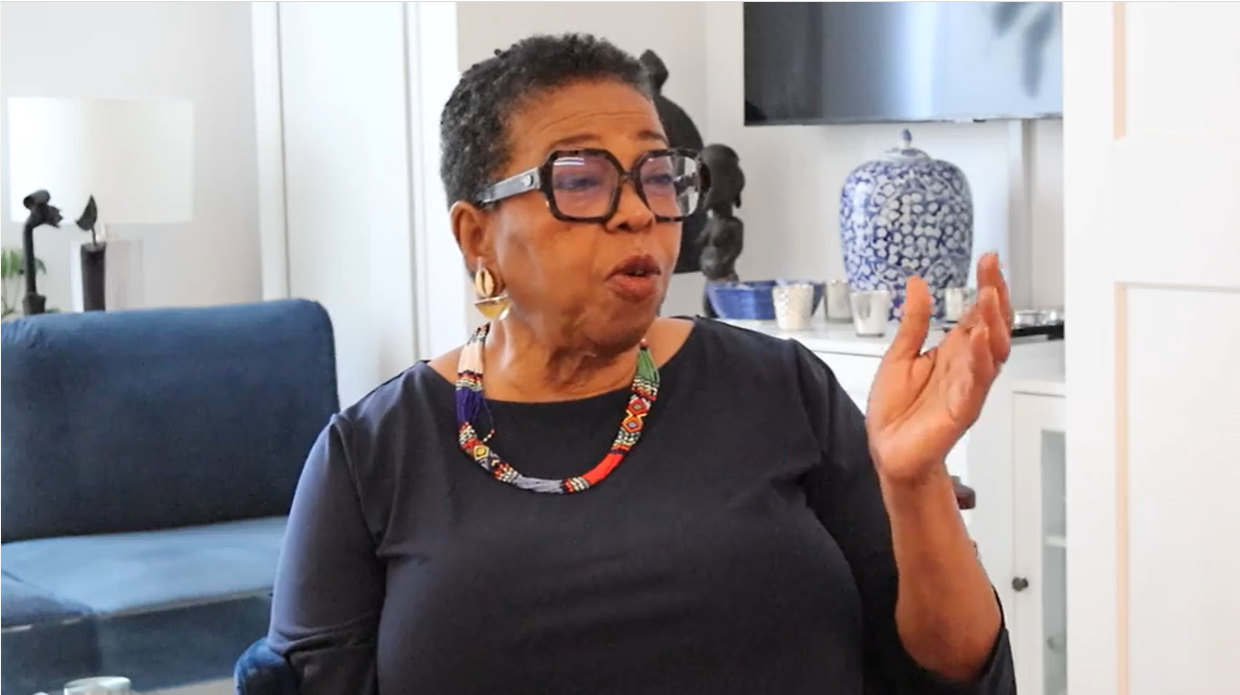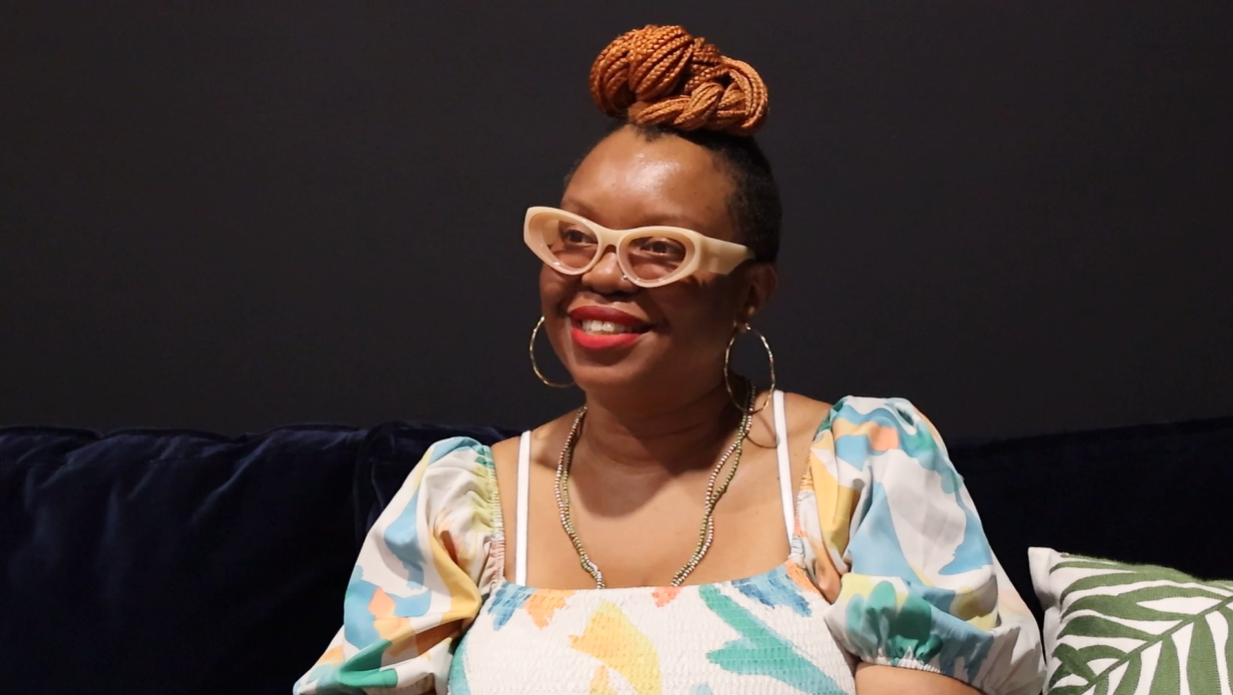-
 Interview with Glenn Hunter
Interview with Glenn Hunter jah elyse sayers interviews Glenn Hunter, co-executive director of Harlem Cultural Archives Historical Society and lifelong Harlemite.
-
 Interview with Lynn Kilgore Hendy
Interview with Lynn Kilgore Hendy jah elyse sayers interviews Lyn Elda Kilgore Hendy (treasurer, Save Harlem Now!) in the Hendy home on August 12, 2025.
-
 Interview with Valerie Jo Bradley
Interview with Valerie Jo Bradley jah elyse sayers interviews Valerie Jo Bradley. Included: video excerpt from interview, full audio file, full transcript
-
 Interview with Sabine Blaizin
Interview with Sabine Blaizin Sabine Blaizin, Deputy Director and Head of Programs at the Caribbean Cultural Center African Diaspora Institute, sits down with jah elyse sayers, Research Associate at the Place, Memory & Culture Incubator, to discuss her cultural work and the experiences that brought her to it. She shares about her childhood in the Bronx, her Haitian roots, the family members that shaped her understanding of herself and the world, her art and spiritual journey, and the necessity of coalition-building strategies in protecting communities from displacement.
-
 Oral History Interview with Kazembe Balagun by Samantha Fox
Oral History Interview with Kazembe Balagun by Samantha Fox Samantha Fox, M. Arch student at Spitzer School of Architecture, interviews Kazembe Balagun, Executive Director of Maysles Documentary Center, on November 8, 2024.
The image paired with this interview is a 2022 illustration (color pencil on paper) titled "Kazembe Balagun, Black Militant Study" by Shellyne Rodriguez. Shellyne Rodriguez is a Bronx-based artist, educator, historian, writer, and community organizer who works in a variety of media, including drawing, painting, collage, and sculpture. Rodriguez stewards the histories and stories of people that have shaped her lived experience, describing her practice as “the depiction and archiving of spaces and subjects engaged in strategies of survival against erasure and subjugation.” Through her multidisciplinary practice, Rodriguez documents the ways in which the diverse social fabric of the South Bronx is rewoven as the people and cultures coexist. Rodriguez utilizes language as well as cultural and sociopolitical references to create unified portraits of individuals from various communities formed in what she describes as the “periphery of empire.” Engaging with the legacy of the Ashcan School, who bore witness to the rise of the modern metropolis and depicted how the poor and working class in New York enclaves were transformed by this, Rodriguez views figures such as Alice Neel, Jane Dickson, and Martin Wong as an extension of this tradition and situates her practice alongside them.
 Interview with Glenn Hunter jah elyse sayers interviews Glenn Hunter, co-executive director of Harlem Cultural Archives Historical Society and lifelong Harlemite.
Interview with Glenn Hunter jah elyse sayers interviews Glenn Hunter, co-executive director of Harlem Cultural Archives Historical Society and lifelong Harlemite. Interview with Lynn Kilgore Hendy jah elyse sayers interviews Lyn Elda Kilgore Hendy (treasurer, Save Harlem Now!) in the Hendy home on August 12, 2025.
Interview with Lynn Kilgore Hendy jah elyse sayers interviews Lyn Elda Kilgore Hendy (treasurer, Save Harlem Now!) in the Hendy home on August 12, 2025. Interview with Valerie Jo Bradley jah elyse sayers interviews Valerie Jo Bradley. Included: video excerpt from interview, full audio file, full transcript
Interview with Valerie Jo Bradley jah elyse sayers interviews Valerie Jo Bradley. Included: video excerpt from interview, full audio file, full transcript Interview with Sabine Blaizin Sabine Blaizin, Deputy Director and Head of Programs at the Caribbean Cultural Center African Diaspora Institute, sits down with jah elyse sayers, Research Associate at the Place, Memory & Culture Incubator, to discuss her cultural work and the experiences that brought her to it. She shares about her childhood in the Bronx, her Haitian roots, the family members that shaped her understanding of herself and the world, her art and spiritual journey, and the necessity of coalition-building strategies in protecting communities from displacement.
Interview with Sabine Blaizin Sabine Blaizin, Deputy Director and Head of Programs at the Caribbean Cultural Center African Diaspora Institute, sits down with jah elyse sayers, Research Associate at the Place, Memory & Culture Incubator, to discuss her cultural work and the experiences that brought her to it. She shares about her childhood in the Bronx, her Haitian roots, the family members that shaped her understanding of herself and the world, her art and spiritual journey, and the necessity of coalition-building strategies in protecting communities from displacement. Oral History Interview with Kazembe Balagun by Samantha Fox Samantha Fox, M. Arch student at Spitzer School of Architecture, interviews Kazembe Balagun, Executive Director of Maysles Documentary Center, on November 8, 2024. The image paired with this interview is a 2022 illustration (color pencil on paper) titled "Kazembe Balagun, Black Militant Study" by Shellyne Rodriguez. Shellyne Rodriguez is a Bronx-based artist, educator, historian, writer, and community organizer who works in a variety of media, including drawing, painting, collage, and sculpture. Rodriguez stewards the histories and stories of people that have shaped her lived experience, describing her practice as “the depiction and archiving of spaces and subjects engaged in strategies of survival against erasure and subjugation.” Through her multidisciplinary practice, Rodriguez documents the ways in which the diverse social fabric of the South Bronx is rewoven as the people and cultures coexist. Rodriguez utilizes language as well as cultural and sociopolitical references to create unified portraits of individuals from various communities formed in what she describes as the “periphery of empire.” Engaging with the legacy of the Ashcan School, who bore witness to the rise of the modern metropolis and depicted how the poor and working class in New York enclaves were transformed by this, Rodriguez views figures such as Alice Neel, Jane Dickson, and Martin Wong as an extension of this tradition and situates her practice alongside them.
Oral History Interview with Kazembe Balagun by Samantha Fox Samantha Fox, M. Arch student at Spitzer School of Architecture, interviews Kazembe Balagun, Executive Director of Maysles Documentary Center, on November 8, 2024. The image paired with this interview is a 2022 illustration (color pencil on paper) titled "Kazembe Balagun, Black Militant Study" by Shellyne Rodriguez. Shellyne Rodriguez is a Bronx-based artist, educator, historian, writer, and community organizer who works in a variety of media, including drawing, painting, collage, and sculpture. Rodriguez stewards the histories and stories of people that have shaped her lived experience, describing her practice as “the depiction and archiving of spaces and subjects engaged in strategies of survival against erasure and subjugation.” Through her multidisciplinary practice, Rodriguez documents the ways in which the diverse social fabric of the South Bronx is rewoven as the people and cultures coexist. Rodriguez utilizes language as well as cultural and sociopolitical references to create unified portraits of individuals from various communities formed in what she describes as the “periphery of empire.” Engaging with the legacy of the Ashcan School, who bore witness to the rise of the modern metropolis and depicted how the poor and working class in New York enclaves were transformed by this, Rodriguez views figures such as Alice Neel, Jane Dickson, and Martin Wong as an extension of this tradition and situates her practice alongside them.